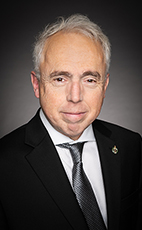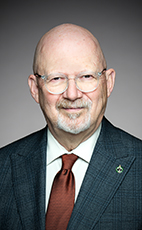44th Parl. 1st Sess.
May 18, 2023 10:00AM
- May/18/23 11:29:19 a.m.
- Watch
Yes, Mr. Speaker, those services are essential. There are functioning addicts, people who have housing but are at risk of losing it if their addiction gets worse. They need support.
They may be addicted because of pain. That pain, be it physical or psychological, needs to be managed. Sometimes people need help to learn how to manage their pain and live with it. Those services are essential, and better funding is urgently needed.
73 words
- Hear!
- Rabble!
- add
- star_border
- share
- May/18/23 11:31:33 a.m.
- Watch
Mr. Speaker, I am a little surprised by the direction of the debate this morning. Actually, I am not that surprised.
The debate is difficult, emotional, sensitive and human, and it affects people deeply. I know what I am talking about because I had first-hand experience with addiction in my family. I was exposed to different kinds of addictions throughout my childhood.
There is no denying that no one ever truly recovers from an addiction. The struggle lasts a lifetime. People who are addicted to drugs continue to be addicts for the rest of their lives, whether they use or not. It is something people are born with, and it is nothing to be ashamed of. Some people are born with addictive tendencies, just as others are born with brown eyes, the ability to run 100 metres in 10 seconds, or to become a soccer champion, a doctor, a major international researcher or a Nobel Prize laureate. People are born with this thing inside them and have to live with it. Judgment has no place in the conversation.
The problem with the Conservatives is that their approach is always a bit dogmatic. It is never easy. However, I would like to point out that they at least deserve some credit for raising difficult, complicated and important issues on their opposition days. In the past few weeks, they have addressed the housing crisis, which is another major crisis that we are dealing with in Quebec and Canada, and even around the world right now. It is a huge issue. The problem is their proposed solution.
Another Conservative opposition day focused on the carbon tax. They want to eliminate the carbon tax. The Conservatives were broaching another important issue of our time, another fundamental crisis that we are dealing with, the climate crisis. They suggested eliminating the carbon tax, but they did not suggest any other solutions.
Is it the same thing for the housing crisis. What solution did the Conservatives suggest? They suggested eliminating municipal governments. According to the Conservatives, there is one level of government too many in this country. We agree with the fact that there is one level of government too many. We could get on board with the option of eliminating one. However, we disagree with the Conservatives as to which level of government is unnecessary.
The Conservatives are raising these important issues, but they are presenting simplistic solutions that we are not sure will get us anywhere. The United States tried the “tough on crime” approach. My colleague spoke about it earlier. The Conservatives are suggesting being tough on drug addicts. They always want to take a punitive, prohibitive approach. If they see something as a problem, then they want to get rid of it. However, as I said earlier, when someone is born with this problem, they have to live with it every day.
The United States, a country recognized for its strict drug policies, has not managed to stem drug consumption. In the United States, opioid-related deaths increased from 50,000 in 2015 to almost 100,000 in 2021. This punitive approach towards drug users has had no impact on drug consumption in the United States. That is more or less the Conservatives' approach this morning. That is roughly what they are proposing.
The U.S. also has the highest incarceration rate in the world, and that is connected with drugs and drug consumption. This record disproves the ideological approach introduced by Nixon long ago. As mentioned earlier, some areas of the United States have changed tack, adopting an approach similar to those developed by Switzerland and Portugal.
In 2001, Portugal changed its approach to combatting drug consumption and the accompanying HIV epidemic by decriminalizing simple possession of drugs. This worked in Portugal. In the many studies that have followed, a new paradigm has emerged. We are familiar with it, and the Bloc supports it. Drug consumption is not just a criminal justice issue, it is first and foremost a public health issue.
Let us talk about public health. The Conservatives can be criticized for being dogmatic in their approach today. However, if we start from the paradigm that this is a public health and mental health issue, because it is, then health care needs to be funded properly. We need to help people, support them in the process, but that takes money. It takes people to support them, like psychologists and nursing aids. It takes centres where they will be supported. It is a mental health and public health problem. For that, health care needs to be properly funded.
What have we seen in the past few months? Over the past 30 years, every province in this country has been complaining non-stop about the lack of adequate funding for health care. There were negotiations recently. What happened? Quebec asked for $6 billion a year. We got barely $1 billion. Is that how we acknowledge the work of people who work in this field? Is that how we acknowledge even the most basic needs on the ground right now? The answer is: of course not. On one hand, the Liberals have an approach we can agree on, but it is largely underfunded, so we are left with a problem.
With substance use comes poverty. As my colleague mentioned earlier, this is another important issue related to the opioid crisis. With poverty comes difficulty finding housing. Difficulty finding housing means there is a housing crisis. There is a housing crisis in this country. How many times have we talked about it? I cannot believe how many times we have to repeat the same things in the House.
I am going to talk about the housing crisis because it is fundamental and it is related to what we are talking about today, although those on the other side of the House will not admit it. On Monday night, I was here in committee of the whole with the Minister of Housing and Diversity and Inclusion on the other side, the director of the Canada Mortgage and Housing Corporation, or CMHC, and all the senior officials from the department, and it was a pathetic display.
I have no doubt that the Minister of Housing is a very nice person. I do not want to be partisan in saying this, and I apologize, but he does not have the know-how to deal with the crisis that we are facing right now. That was very clear on Monday night. We were asking some very pertinent questions.
The challenge is real. Even the Liberals know it. The minister identified the housing problem that we have in this country. We must build 3.5 million housing units by 2030. He said so himself. We do not even need to tell him what the challenge is; he knows what it is. What is happening?
According to the National Housing Council, 115,000 housing units have been built since the national housing strategy was launched. I will remind members that we need 3.5 million units. We have built 115,000 units, but members might want to hold on to their hats, because according to the National Housing Council, we have lost 550,000 affordable housing units. We are in the red.
Over the past five years, the government has implemented an $82‑billion program. Not only are housing units not being built, but people have less access to housing. People with addictions could benefit from social housing with supports. It is desperately needed.
Let me close with this. As I mentioned earlier, an economist at the CMHC said that, in Quebec alone, 1.1 million housing units need to be built in the next 10 years. On its own, the market will build 500,000 units. Everyone needs to mobilize, all of us here in the House and all levels of government, to find a way to build 600,000 units in the next 10 years. That means 60,000 a year. Only 115,000 have been built in the last five years, so we are nowhere near that goal.
There are a number of considerations, including funding for housing and health care. There is also a human element underlying all of this. There are tragedies and families who have lost loved ones.
We need to mobilize. Unfortunately, dogmatic motions like the one the Conservatives introduced this morning will not move the debate forward.
1414 words
- Hear!
- Rabble!
- add
- star_border
- share
- May/18/23 12:16:50 p.m.
- Watch
Madam Speaker, I will be splitting my time with the hon. member for Peterborough—Kawartha.
After eight years of the Prime Minister, everything feels broken. Life costs more. Work does not pay, and housing costs have doubled. The Prime Minister divides to control the people. Worst of all, crime and chaos, and drugs and disorder rage in our streets. Nowhere is it worse than the opioid overdose crisis that has expanded so dramatically in the last several years.
This is an important debate we are having today. The opioid addiction crisis is real, and it is costing Canadian lives. The unimaginable pain that those who are suffering from addictions are going through, as well as that of their families, their friends and their loved ones, cannot be understated.
I know that many of us here have probably gone to too many funerals, and I know I have, of those who were suffering from addiction because of this crisis. Many times when we talk about those who are addicted or people who are struggling with addiction, we think about the people who we might see in the downtown or who might be homeless. It is true, some of them are. However, very often they are also the people we know, people we may not have expected, people who might be family members, co-workers, friends or neighbours, people who we would not expect to be in that situation but are in this crisis and are suffering from addiction.
We know there is no simple solution. The issue here is very complex and there are many factors that affect it. What we can see is that the Liberal government approach is not working. The Liberal plan is not helping those who are struggling to get past their addiction and fully recover. In fact, those Liberal policies have actually made the situation worse.
I want to read from the text of the motion today. It says:
...given that,
(i) Canada is in the midst of an opioid crisis that has killed over 35,000 people since 2016,
(ii) since 2017, the federal government has spent over $800 million on its failed Canadian Drugs and Substances Strategy, including over $100 million in funding for hard-drug supply projects across Canada, and plans to spend an additional $74 million to “scale up” these projects over the next five years,
(iii) since tax-funded drug supply was ramped up in 2020, opioid deaths have only gone up, according to the Public Health Agency of Canada,
(iv) in 2020, slightly less than 7,000 people died of opioid overdoses, while only 3,000 died of overdoses in 2016, according to the Library of Parliament,
(v) in British Columbia alone, yearly drug overdose deaths have increased by 330% between 2015 and 2022,
(vi) recently, a Global News reporter in East Vancouver was able to buy 26 hits for $30 in just 30 minutes of a dangerous and highly addictive opioid that is distributed in tax-funded drug supply programs and flooding our streets with cheap opioids,
the House call on the government to immediately reverse its deadly policies and redirect all funds from taxpayer-funded, hard drug programs to addiction, treatment and recovery programs.
What would Conservatives do?
Conservatives believe that addiction is a health condition and that it should be treated as such. A Conservative government would have a recovery-oriented system of care that helps people on their journey. This means prevention, intervention, treatment and recovery. Conservatives believe that we have to meet people where they are at, but we need to stop leaving them there. We should be helping them get their lives and their families back, and help them fully recover.
It is not just that the Liberal program is a failed experiment that has been tried and which has failed in other cities in other parts of the world. The scary part is that their program is adding more drugs to the streets, which is making the drug supply cheaper, so there are now more drugs on the streets. It has become more affordable for those trying to purchase them.
There is a B.C.-based physician who says that, before safe supply, before the government's program, 8 milligrams of hydromorphone tablets sold for $10 in Vancouver's downtown east side. The doctor says it now costs between 50¢ and a dollar.
Dr. Vincent Lam, the medical director of Coderix Addiction Therapy, provided insight into the situation in downtown Toronto, so we are going from from Vancouver to Toronto. According to his patients, 8 milligrams of the same drug tablets that used to go for $20 on the street now sell for between two dollars and five dollars, and sometimes as little as one dollar.
A doctor in Ottawa said that 24 milligrams of hydromorphone, which they believe came from the city's safe supply facilities, sells for two dollars on the street. Before safe supply, they were selling for $20 to $30. A representative from the Nanaimo Area Network of Drug Users said that the system is broken. They estimated that up to 80% of safe supply drugs in Nanaimo, B.C., are currently being diverted. The system definitely is broken. It is not working.
What is happening is that those who are struggling with these addictions are selling the drugs they are receiving from the government. They are selling them because they need stronger drugs. These ones do not work any more. They are selling them at such a low cost that even our young Canadians, children and youth, are able to buy them for one or two dollars a hit. We are creating a cycle where more and more Canadians are getting more addicted rather than breaking that addiction.
This crisis has left Canadians struggling right across the country, and it does not see background or religion. I have talked to many parents in South Asian communities who have seen their children go through these addictions and go through the struggle.
I visited a gurdwara in Surrey where the head of the gurdwara said that they have sent home international students, and we are talking hundreds across the country. They have had to send home their bodies. Many of them have stresses. There are pressures that they face, having come to Canada. They are young, and it is different, so there is loneliness. There are pressures on them, financial stress. Many of them have become addicted to drugs, and many of them have overdosed. This itself has become a pandemic and a serious crisis in the community.
All of this, addictions, the use of drugs and the supply of drugs, have also led to more gang activity as well, which has led to more of our young people dying. They are being killed in gang activity. Conservatives' common-sense plan would end taxpayer dollars for drugs and put people in addiction, treatment and recovery programs. Conservatives will bring our loved ones home, drug-free.
1169 words
- Hear!
- Rabble!
- add
- star_border
- share
- May/18/23 12:28:52 p.m.
- Watch
Madam Speaker, I can hear the Conservatives' concern. As my colleague from Longueuil—Saint-Hubert said earlier, we are addressing an extremely sensitive and important issue, but they are not providing effective and vetted solutions. The Conservatives' approach is very similar to that of the Americans. It has been said before. We have been saying it since this morning. The results in the United States are not very encouraging. Quite the opposite. The number of opioid-related deaths has dramatically increased since 2015. The Conservatives' suggestion is to focus more on rehabilitation centres, centres to help addicts get off drugs. Those already exist and they are working, but the crisis keeps getting worse.
Does my colleague not think that it is time to focus on new ways of dealing with drug addiction, as has proven to be successful elsewhere in the world, unlike the American approach, which has shown to be ineffective?
154 words
- Hear!
- Rabble!
- add
- star_border
- share
- May/18/23 12:29:59 p.m.
- Watch
Madam Speaker, it is true that we do have recovery programs in Canada, but the problem is that we need more of them; they need to be more available. I talk to many parents whose children are suffering from these addictions about recovery programs. There are long wait times, and some of these programs are extremely expensive, so they are not able to get their children into these programs, nor their family members, their friends or whoever they may be.
Our plan is to stop giving taxpayer-funded hard drugs to those with addictions, and it is to put all that money the government has been providing to that into addiction programs to help those struggling with addictions through treatment. That is what would help Canadians right across the country.
130 words
- Hear!
- Rabble!
- add
- star_border
- share
- May/18/23 12:32:27 p.m.
- Watch
Madam Speaker, after eight years of the Prime Minister, everything feels broken. Life costs more, work does not pay and housing costs have doubled. The Prime Minister divides to control the people. Worst of all, crime and chaos, drugs and disorder rage in our streets. Nowhere is this worse than the opioid overdose crisis, which has expanded so dramatically in the last several years.
This is a really tough subject, and it is very tough when we are challenging what many people thought they knew. Addiction is a ruthless, cold-blooded thief. It is a vile disease that destroys families and lives. It is a disease that preys on its innocent host in unimaginable ways. Addiction will make the victim say and do anything to anyone in order to eliminate the pain.
That is where we need to focus our efforts, and that is what our opposition motion today does. Instead of putting a band-aid on the gushing wound, Conservatives are saying, let us treat the trauma and let us destroy the predator and save the host. Conservatives are calling on the Liberals to redirect their taxpayer money from safe supply to treatment and recovery and bring our loved ones home. Conservatives are asking to invest in understanding why and to fund recovery. Conservatives want to give people suffering with addiction back their life, their family and their body.
I believe safe supply is one of the most powerful marketing campaigns ever released. Let us be honest. If a loved one had a life-threatening disease, people would buy or agree to anything that would keep them alive. They would not ask questions. They would just hear that it would keep them alive and sign the dotted line. The idea of safe supply has sold a whole culture of people a falsehood, a hope that they will save their loved ones, but the reality is that safe supply just keeps them where they are. It allows addiction to continue to prey on its innocent host. Honestly, it is a hell of a business model. Why not keep the customer coming back for more?
There is a distinct difference between OAT and safe supply, and it is critical that everyone watching listens to the difference, because once they do, I believe they will understand that Conservatives are the only party offering a compassionate solution to the biggest crisis our country has ever suffered.
Evidence-based medication refers to opioid agonist therapy, or OAT. It includes drugs such as Suboxone, Sublocade and methadone. This is different from Canada's safe supply, which includes drugs like hydromorphone. Hydromorphone is equivalent to heroin.
OAT is a recovery-oriented therapy that addresses the torturous and sometimes deadly withdrawal symptoms that opioid addicts experience when they stop using their drugs. These symptoms are a major barrier to recovery if left untreated. I highly recommend everyone watch Dopesick. It is one of the best public education tools out there to understand this.
I have many friends who have lived a full life or who live a full life in recovery thanks to OAT. With OAT, those in recovery are given long-lasting, milder opioids that stave off withdrawal without providing any high or euphoria, helping patients live free of narcotic impairment. The administration of OAT is tightly controlled. Patients generally must come to a clinic every day for supervised consumption. Take-home use is strictly monitored.
In contrast to OAT, safe supply drugs are intended to mimic the highs of illicit substance use, not manage withdrawal. Safer supply does not move patients toward a drug-free life. It is, in theory, intended to prevent overdoses and death until one is ready to begin their recovery journey.
Many people who are not on board with our solutions will say that it is the deadly supply of fentanyl on the streets that is killing people, and they are absolutely correct, but guess how those dealing with addiction are getting that deadly, toxic dose of fentanyl? They are selling their government-funded safe supply. Why are they selling their government-funded safe supply? It is because they need a stronger high. Never before have we had such powerful drugs. The physiological dependence on these drugs cannot be overstated.
It turns out that hydromorphone is too weak to get fentanyl users high, and, for this reason, many safer supply recipients simply sell (“divert”) their government-provided hydromorphone on the street, at rock-bottom prices, to purchase more street fentanyl. Safer supply doesn’t dissuade illicit fentanyl consumption—it subsidizes it.
That is a direct quote from Adam Zivo from the National Post.
The type of studies they (safer supply advocates) are doing are the weakest. The bottom line is that they're not comparing—this is the unethical part—they're not comparing hydromorphone programs to the standard of care, which is methadone.... That would be more ethical.
That was said by Dr. Lori Regenstreif.
...it's very common for my patients to tell me that they know people who sold most, if not all, of their prescriptions for PSADs [public supply of addictive drugs]. Unfortunately, that means that the hydromorphone is going somewhere else.
That was said by Dr. Vincent Lam.
How do we prevent overdoses? We must invest in prevention, in naloxone and in programs that treat the “why” in addiction. Until people who are addicted understand why they are using, they will never be free. Until people have the support they need, they are stuck. Conservatives are asking this House and demanding that the Liberals redirect funding from safe supply to treatment and recovery.
Canada is in the midst of an opioid crisis that has killed over 35,000 people since 2016, and that number does not account for the collateral damage that addiction leaves for families. How many kids are traumatized because their parent is stuck in the grip of addiction or has lost a parent, a sister, a mother, a daughter, a brother, an aunt to addiction?
Since 2017, the federal government has spent over $800 million on its failed Canadian drugs and substances strategy, including over $100 million in funding for hard-drug supply projects across Canada, and plans to spend an additional $74 million to scale up these projects over the next five years. Since tax-funded drug supply was ramped up in 2020, opioid deaths have only gone up, according to the Public Health Agency of Canada. In 2021, more than 8,000 people died of opioid overdoses, while less than 3,000 died of overdoses in 2016. It is not working.
I just cannot explain a more horrible disease than addiction. There are parents at home right now who are waiting for a phone call because they had a bright, amazing child who maybe got hurt and was prescribed opioids or maybe had trauma and used drugs to escape the pain. They are waiting for a phone call saying their child has died. Imagine if the Liberals committed to spending $800 million on treatment and recovery instead of drugs that are funding drug dealers. I know this is hard. So many people got sold an idea and it was wrong. Again we see an example of the government spending money in all the wrong places.
The path out of addiction takes full commitment, and access to treatment and recovery must be available instantly. Seconds matter. We need housing away from the life that will put them back where they were, and we need to invest in prevention. Mentally healthy, resilient kids turn into mentally healthy, resilient adults. Treating the problem with the problem is not a solution. Safe supply is killing our children. The data is in, and overdoses are up 300%.
Today the Conservatives are asking the House to call on the government to immediately reverse its deadly policies and redirect all funds from taxpayer-funded hard-drug programs to addiction treatment and recovery programs. Let us be leaders and invest in recovery and treatment, and let us bring everyone's children home safely.
1352 words
- Hear!
- Rabble!
- add
- star_border
- share
Madam Speaker, I will be splitting my time with the member for Cariboo—Prince George. Today, I stand before members to express my deep concerns about Canada's mental health and addiction crisis.
After eight years of the Prime Minister, everything feels broken. Life costs more. Work does not pay. Housing costs have doubled. The Prime Minister divides to control the people. Worst of all, crime and chaos, drugs and disorder rage in our streets. Nowhere is this worse than the opioid overdose crisis that has expanded so dramatically in the last several years.
Many Canadians continue to be repeatedly traumatized by the Liberal government and its failed policies. As a result, we are dealing with a mental health and addiction crisis. Canadians struggling with addiction deserve compassion with access to appropriate treatments and a plan for recovery.
Addiction is a public health issue and Canada’s drug laws must target individuals who prey on Canadians struggling with addictions, more specifically those who engage in trafficking and the sale of illegal drugs. My Conservative colleagues and I oppose removing deterrence measures for those who exploit Canadians struggling with addiction.
Expanding access to treatments and recovery programs should be a health care priority to get help to people struggling with addiction. While the Liberals continue to push their own narrative, there is not even one real definition of “safe supply”. How are dangerous, toxic drugs safe?
The safe supply is continuing to destroy lives. It has led to more addiction, more deaths and more despair. We believe that we must stop taxpayer-funded hard drugs, and instead fund treatment and recovery, and bring home our people drug-free.
Liberal safe-supply policies do nothing to bridge people toward recovery. Instead, people are being trapped in a cycle of addiction. In March of 2020, an article titled “Is All 'Safe Supply' Safe?” was published by the Canadian Society of Addiction Medicine. The Liberal-NDP coalition has given up on Canadians struggling with addiction and has essentially put them straight into palliative care.
The greater societal cost is playing out with this experiment in British Columbia. The Minister of Mental Health and Addictions referred, in this place, to following proper indicators without saying what they are. I am not sure what those indicators are because according to the Public Health Agency of Canada, since tax-funded drug supply was ramped up in 2020, opioid deaths have only gone up.
In 2021, more than 8,000 people died of opioid overdoses, while fewer than 3,000 people died of overdoses in 2016. In British Columbia alone, yearly drug overdose deaths have increased by 330% between 2015 and 2023.
In addition, just ahead of the seventh anniversary of B.C. declaring a public health emergency, B.C. Emergency Health Services released grim statistics last month. B.C. set records in March, two months ago, for the most overdose calls in one day, the highest 30-day average of overdose calls and the most consecutive days where paramedics attended 100 or more poisonings. Our first responders are overburdened and exhausted.
This is with drug decriminalization and so-called safe supply in place. B.C. is apparently also on pace to set a new record for poisoning calls in a year and match its annual record for the most naloxone doses administered to reverse the effects of opioids. Those are the facts.
Recently, a Global News reporter in east Vancouver was able to buy 26 hits for $30, in just 30 minutes, of a dangerous and highly addictive opioid that is distributed in tax-funded drug supply programs. It is flooding our streets with cheap opioids.
A new black market has been created and this is perpetuating the cycle of addiction. It has been reported that physicians are saying this is even leading to a rise in new addictions, particularly among youth and those recovering from addictions. Those are the facts.
These are the results of the Liberal drug policies. These are more lives lost. Our streets are less safe and people are dying. The other day, here in the House of Commons, I was appalled by the shouting and applause that the Liberal and NDP MPs showed as I mentioned the terrible effects of open drug use in parks and playgrounds, which they support. I had to start my question three times because of the disruption. These are policies that harm children’s safety, as people are getting high and leaving syringes and other drug paraphernalia in playgrounds.
Open drug use in parks and playgrounds where children play is unacceptable, and it is evident that the federal Liberal government is not taking public safety seriously.
On this side of the House, we do take this issue very seriously. We recognize the need to approach these issues with compassion. That is why we will continue to advocate for stopping the flood of dangerous drugs on our streets and also advocate for recovery, treatment and rehabilitation.
This is some of what my private member's bill, Bill C-283, the end the revolving door act, sought to do. It sought to create a common-sense framework for the commissioner of Correctional Service Canada to be able to designate all or a part of a federal correctional facility as an addiction treatment facility. If individuals met certain parameters at the time of sentencing, a judge could offer the choice to be sentenced to participate in a mental health assessment and addictions treatment inside a federal penitentiary while they served out their sentence.
Bill C-283 was in line with the House of Common’s support for Bill C-228 in the previous Parliament to establish a federal framework to reduce recidivism, where healing is the best path toward reducing recidivism in Canada.
I received much positive feedback and support on this bill from across the country, from business groups, from those working in criminal justice and from those working in recovery, like the founder of Freedom's Door. I also received unanimous support through a resolution of the City of Kelowna.
This common-sense legislation was voted down by the Liberal and NDP members. They are not focusing on recovery and treatment and are quite fine with the status quo.
After eight years of Liberal incompetence, Canadians are suffering. I hear from parents in my riding all the time who want their child to access support and rehabilitation. It is heartbreaking the government has given up on some of the most vulnerable in our society and has put them straight into what one could consider perpetual addiction and palliative care.
In B.C., it is unbelievable, due to how open drug use is now rampant and playing out in our communities, that we even need to have a conversation that open drug use should be banned from playgrounds and parks. These drug decriminalization policies have affected neighbourhoods in B.C., as this three-year drug decriminalization experiment is playing out.
Municipal governments across B.C. have been forced to look at how to make their communities more safe for their citizens, and in particular in parks and playgrounds. Municipalities that have either already implemented bylaws, were looking at bylaws and/or have advocated to the provincial government include Kamloops, Kelowna, Sicamous, Campbell River, Nanaimo, Maple Ridge and Prince George, and there may be others.
However, it is not just at the human level that the Liberals refuse to show compassion. The Prime Minister refuses to stand up to the greedy pharmaceutical companies that cynically marketed addictive drugs as pain medication. That is why we in the official opposition are committed to bringing home justice for the victims of addiction.
Our Conservative leader announced months ago a commitment to launching a massive federal lawsuit against big pharma and their consultants, and to joining the active B.C. lawsuit to cover the costs of the epidemic to our border security, courts, the criminal justice system, indigenous programs, lost federal tax revenue and massively expanded treatment programs. The intention with this is the money recovered from this massive lawsuit will fund treatment and recovery programs for people struggling with addiction. It is from big pharma that originally safe supply came from.
The Conservatives are focused on turning hurt into hope by presenting common-sense solutions to address the addictions crisis facing our communities and the revolving door in our justice system. While the Liberal-NDP group has turned its back on society's most vulnerable, the Conservatives will continue to advocate for support, compassion and rehabilitation so we can bring home our family members and fight back against this horrible addiction crisis, which the Liberals have fuelled by their failed policies.
1457 words
- Hear!
- Rabble!
- add
- star_border
- share
- May/18/23 1:31:44 p.m.
- Watch
Madam Speaker, as I mentioned at the very outset of my speech, people are in a really desperate space. It is leading to this addiction and mental health crisis.
People cannot afford to live. They cannot afford to feed themselves. They cannot afford medicines. The price of everything is going up. Inflation is affecting people's everyday lives. I hear about this in my riding. People cannot even afford their rent or mortgage. Everything has doubled. Rents and mortgages have doubled. People are getting into a very desperate space.
This is fuelling the addiction and mental health crisis. We need to deal with the economic side, while we also deal with this very serious addiction issue.
116 words
- Hear!
- Rabble!
- add
- star_border
- share
- May/18/23 3:40:00 p.m.
- Watch
Mr. Speaker, I rise on a point of order. Addiction is a complex issue and the deadly opioid epidemic, which has been fuelled by a poisoned drug supply, requires a compassionate, evidence-based approach to save lives.
Recently, members of the Conservatives, including the MP for Saskatchewan—
48 words
- Hear!
- Rabble!
- add
- star_border
- share
- May/18/23 3:56:16 p.m.
- Watch
Mr. Speaker, on the motion that we are debating today, I get the impression that no one is budging from their position.
When I was teaching I used a book as an analogy. If I describe a cover and the person across from me describes the other cover, we will not have the same description. However, in the end, what matters are the pages between those two covers. Here, the objective is to find and implement everything we can to help people who have an addiction, whether that is services, protected sites or safe supply.
I would like my colleague to talk about the importance of health transfers for ensuring adequate service delivery to people who are addicted.
118 words
- Hear!
- Rabble!
- add
- star_border
- share
- May/18/23 4:27:32 p.m.
- Watch
Madam Speaker, after eight years of the Prime Minister, everything feels broken. Life costs more. Work does not pay, and housing costs have doubled. The Prime Minister divides to control the people. Worst of all, crime and chaos, drugs and disorder rage in our streets. Nowhere is this worse than the opioid crisis, and that has expanded so dramatically in the last several years.
Across the board, we see that the government is not working. That is why I am in full support of today's opposition motion, which proposes to reverse the damage being done by the Liberal government's drug policy and advances an authentically compassionate alternative approach to the opioid crisis.
Conservatives believe in universal and immutable human dignity. When it comes to those who are struggling with addiction, we believe in both meeting people where they are at, helping them pursue an ambition for recovery, and doing it successfully.
The approach of all of the other parties in this place reflects a basic pessimism about the potential of those struggling with addiction. They want to meet people where they are at, but leave them there, while we want to meet people where they are at and help them pursue recovery. Parents, brothers, sisters and friends do not just want to see those struggling receive a kind of palliative care. They want to see us take the steps that would allow those who are struggling to come home drug free.
This means that we need to make smart choices with scarce resources by investing those resources in treatment and recovery instead of spending those dollars to buy dangerous drugs and give them a away. The approach of every other party in the House is to dramatically increase the supply of dangerous hard drugs into our neighbourhoods. They argue that this is an appropriate response to the drug supply being poisoned, and because of a poisoned drug supply, they want to offer cleaner versions of these drugs.
Let us be clear, hard drugs are poison. Giving away taxpayer-funded poison is not a solution to people being poisoned. Giving away less potent versions of these drugs ignores the nature of opioids themselves. Opioids have a tolerance-inducing effect, which means that people generally need higher and higher doses to achieve the same impact. If a person is on a course of treatment and recovery, where they are offered targeted alternatives with unique properties, then they can go the other way. However, absent the intentionality, the reflexive course of opioid use is a dangerous upward escalator. Free, government-funded opioids today would still lead to the use of even more potent, unregulated opioids tomorrow.
As we are seeing now, this policy of supplying government-funded hard drugs into neighbourhoods and communities does not just hurt those who are already facing addictions. It also makes these hard drugs more plentiful, more available and easier for vulnerable kids to access for the first time. We know this because of what we are seeing in B.C., where these so-called safe supply policies have been tried. We also know this because of the particular history of the opioid crisis. This is where I want to focus my remarks today.
Where did the current opioid crisis come from? The evidence shows us that most people who struggle with opioid use disorders did not start down this road by experimenting with street drugs. They started down this road because a family-owned pharmaceutical company called, Purdue Pharma set out, starting in the 1990s, to revolutionize pain management through the aggressive marketing of OxyContin, and sought to make a lot of money in the process.
This history is well told in a number of books. I would recommend Empire of Pain by Patrick Radden Keefe, Dreamland by Sam Quinones and chapter seven of When McKinsey Comes to Town.
Here is the essential background: Opium is the original opioid, and there was a long-standing reluctance in the medical community to prescribe it, except in the most extreme cases. Purdue Pharma sought to create the impression that OxyContin, its new semi-synthetic opioid was less potent than opium. It was actually more potent. OxyContin also incorporated a controlled release technology. It was designed to facilitate a controlled release of opioid-related pain relief over a period of time. This also helped create an illusion of less risk.
However, OxyContin's controlled release mechanism was not tamper resistant. It could easily be modified to release all of the hit at once. It carried all of the same risks as, in fact greater risks than, opium. Purdue Pharma made unfounded claims minimizing the addiction risk associated with OxyContin and aggressively marketed it as the solution for all kinds of pain, not only acute pain following an extreme event but also ongoing chronic pain. It was marketed as a low-risk powerful pain relief option, and it was marketed very successfully.
As a result, many people with different levels of short-term and long-term pain had the opioid OxyContin prescribed to them. Then, because of the now well-known tolerance-inducing effect associated with opioids, people could not get the same level of pain relief at the same dose. They would seek higher and higher doses, and eventually transition away from just prescription drugs to street drugs as well.
For those here or elsewhere who have lost loved ones to opioid use disorders, many will recognize this story. There is pain, perhaps from a car accident or a long-running, unexplained, chronic pain, and then opioids are prescribed, followed by opioid addiction, and a subsequent spiral as higher and higher doses are sought to achieve the same effect. Perhaps, at some point, people seek treatment and recovery, but they find a complete lack of accessible services available.
Purdue Pharma's objective was to minimize any concern or stigma around its new product OxyContin. When it was released in 1996, OxyContin was a new drug, and indeed false claims were made to minimize its risk. It was also sold generally through regulated pharmacies.
This was not about stigma. It was not about unpredictability of supply or alteration of supply. This is actually a test case of what happens when drugs are easily available with little or no stigma. In effect, the overpromotion of opioids by Purdue and others with dangerous pharmaceutical-grade drugs made easily available was the original safe supply program, and that is what gave us the opioid crisis in the first place.
Needless to say, for pioneering this original safe supply program, Purdue is not getting any congratulations. It has become a global pariah and the name of the Sackler family, who owned Purdue, is being stripped off of the universities and art galleries they donated to. This original safe supply program is now seen for what it is. It was an elaborate scheme to market the problem of pain and then sell a solution that was far worse than the problem, undertaken contrary to the evidence and with the sole aim of making one family rich.
Conservatives have advanced a simple proposal in response to the wrongdoing associated with this first attempt at making big pharma rich through so-called safe supply. Our proposal is that Purdue Pharma, the Sackler family and all of the other bad actors involved, including McKinsey, pay compensation for the full cost associated with the opioid crisis and that the government spend 100% of the dollars collected through such litigation to fund treatment and recovery. The government needs to be ready to step up and help, yes, but let us make those responsible for this problem pay to fix it to fill the treatment and recovery gap.
I have not had time to review all of the history here, but there is one piece that I think is particularly noteworthy. The original formulation of OxyContin was said to go off patent in the United States in 2013. However, likely in an effort to extend patent exclusivity, Purdue Pharma released a new formulation of OxyContin with certain abuse-resistant features. It then filed papers with the FDA asking the agency to reject generic versions of the original pill on the grounds that the original version was unsafe. Purdue also pulled the original formulation from the U.S. market. The FDA concurred with the company and blocked generic re-formulations in the U.S. This led to the marketing of a new, somewhat safer, tamper-resistant product, but it also allowed Purdue Pharma to continue to have patent exclusivity in the United States and make even more money.
However, while both Purdue and the FDA said that the original formulation was unsafe, Purdue continued to sell the original, easier-to-abuse version here in Canada for a full year after the original OxyContin was off the shelves in the United States. In other words, Purdue was selling a drug in Canada which they had explicitly lobbied the FDA in the United States to be unsafe. Notably, sales rose dramatically in border areas, quadrupling in Windsor, suggesting that the company knew that the more dangerous versions of the drug were being sold in Canada and smuggled back into the United States. Purdue admitted that it was aware of the resulting spike in OxyContin sales in Canadian border towns. This is clear evidence of Purdue's extreme malice and of the particular impact that this has had for Canadians.
What can we learn from these events? First of all, we need to be constantly aware of the risk of large companies overmarketing potentially dangerous products. This is the cause of the opioid crisis, and we are seeing risks of this happening in other cases. We also must learn that so-called safe supply does not work. Trying to minimize the recognized risks associated with clearly dangerous products, making them widely available through pharmaceutical sales, clearly does not work. It did not work then, as it gave us the opioid crisis in the first place, and it is not working now.
To deter this kind of behaviour, we need to punish the perpetrators of this crime. The perpetrators are not those suffering from addiction, but the bad, elite actors who push these drugs onto people who are unaware of the risks, and who sought to minimize those risks. Therefore, I am pleased to support this motion and to move an amendment to it, which brings in this concept of holding bad actors responsible and of using the resources thus gathered to fund treatment and recovery.
I move, seconded by the member for—
1769 words
- Hear!
- Rabble!
- add
- star_border
- share
- May/18/23 4:57:04 p.m.
- Watch
Mr. Speaker, the Conservative motion somehow implies that safe supply programs are not about fighting addiction, but really more about creating addiction. However, the evidence suggests that these programs are successful in reaching people with addictions more often on a daily basis, so that they can access more tailored recovery support services.
I wonder if my colleague could comment on the benefits of this approach, which may not be perfect in its current form. I would like him to talk about the possible benefits and the improvements that could be made to current programs.
94 words
- Hear!
- Rabble!
- add
- star_border
- share
- May/18/23 4:59:59 p.m.
- Watch
Mr. Speaker, I would like to thank the hon. member for his very reasonable speech in response to the quite unreasonable motion before the House.
In doing so, I would like to ask if he agrees with me on this. On Vancouver Island, there are more than a dozen overdose prevention sites, which people like to call safe consumption sites. They save hundreds of lives every year, but they also help connect those with addiction problems to social services and treatment programs in the community.
Does he agree with me that the closure of those overdose prevention sites would contribute to more deaths and a larger number of addiction problems in the community?
113 words
- Hear!
- Rabble!
- add
- star_border
- share
- menumenu
- notificationsnotifications
- home
- mailmail
- searchsearch












